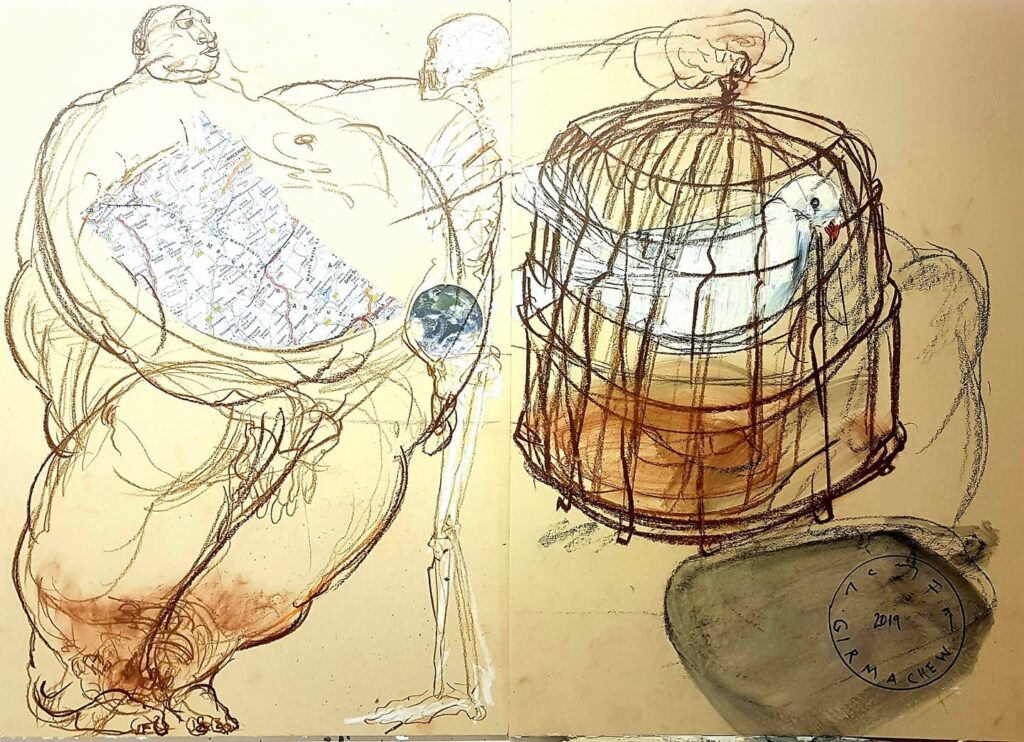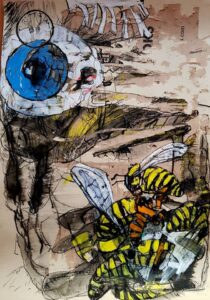
I come from a country, Ethiopia, that was never colonized. I want to pass on my love and respect to my companions who went to war against colonization and defeated Italy. Today I am proud of these people and being Ethiopian, but I have never forgotten that I am also African. And the rest of Africa was colonized. People in the colonized countries lost their original name, tradition, culture, language and religion. All this has been changed by Western cultures.
Girmachew Getnet in conversation with Rob Perrée
Girmachew Getnet: art is not just about being talented and educated, but more about experiencing the feeling of freedom.
A few years ago I received an invitation from Girmachew Getnet (Ethiopia) for an exhibition in Frankfurt together with a Romanian colleague. The title was intriguing: Blurring the Lines. What I knew about his work had everything to do with whimsical black lines that turned his work into a mixture of painting and drawing. An exciting concept. Of course the exhibition title had an underlying meaning. She also referred to the interface between fiction and reality.
I did not go to the opening, but I did follow his work on social media. That was not enough. Therefore I decided to go for an interview with Girmachew. Due to the travel blockages of Covid 19, it had to be an email interview.
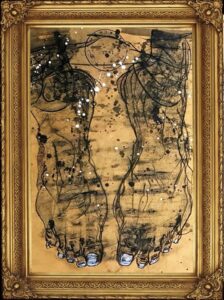
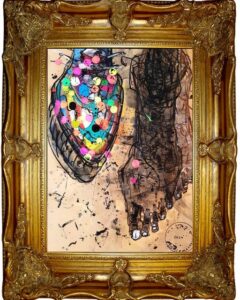
Lockdown (Who is in our shoes), 2020, 80 X 60 cm, drawing/painting on cardbord
What does it mean, growing up in Addis Ababa in your time?
My childhood and youth in Addis Ababa was a golden age, but sometimes difficult. I attended a Catholic primary school, one of the best private schools of the time. I remember that everything there was very disciplined and conservative. Many children came from rich families and from the middle class (by the way, my family was not rich, but middle class).
In the middle of primary school I changed to a state school. There I got to know the real Addis Ababa. The children came from everywhere, some from very poor families. There I learned mainly social skills and how to deal with people. My high school was right next to the art school in Addis Ababa. I spent most of my time in an art club and already started studying art in the evening classes at the art school. I spent more than 6 hours a day practicing still life and human model drawings and preparing for the exams for the art school. I passed the entrance examination, studied at the art academy for 4 years and graduated in the painting department. Immediately afterwards I founded the first art studio in Addis Ababa “Habesha” with fellow graduates.
Did you grow up in a family where artistic qualities counted?
Not really. Most of my brothers and sisters became business people like my father. He had a big business at the large market, Mercato, in Addis Ababa. His wish was that I do the same.
When did you find out that you wanted to be an artist? Was your decision influenced by older artists? By something else?
I found out that I wanted to become an artist when I enjoyed being alone, meditating alone. I did so from a very young age on. Painting is like meditation for me. When I am alone, I can think alone, decide alone. There are no religious and no social boundaries that I have to observe. I can go as far as I like. That is why I have chosen this path of an artist.

Why can’t we just live in peace, 2016. drawing/painting
You had your first exhibitions in Ethiopia. Can you tell something about the infrastructure for art in your mother/fatherland? I have the feeling that there is a lot of good art in your country but that it is hard to present it.
I had my first solo exhibition in the third year of my studies. It took place in the Kennedy Library of the University of Addis Ababa. The exhibition consisted of 30 works of art, which were unique. My aim was to appeal to the students of the university and to challenge their views. It was fun to experience the reverse of the rest of my family, who, as I said, are business people. I never thought about selling the exhibited paintings, because that was not my goal. This contrast to my origin is expressed very well in the Ethiopian proverb “the mother’s womb is different”.
At the time of my studies there was not much art infrastructure in Ethiopia except the art school in Addis Ababa. It was a golden time for every student to spend four years in art school. I mean, for the students who really enjoy art and art life. We had several Ethiopian art teachers who had MA degrees from various art schools abroad, most of them from Russia and some from Germany. Of course, we were also inspired by the senior students’ works. Interesting art exhibitions in Addis Ababa, especially at the German and French cultural institutes, played a big role for art life.
The limitation of the art life to the art academy and cultural institutes changed with the foundation of the “Habesha Art Studio”. I dreamed and planned to found this studio when I was in my third year at art school. The reasons were as follows: Most art students were afraid of what would happen to them after graduation. At that point there were only three options for art students: To work for a private office, for the government or as a designer, or illustrator; to leave the country on a scholarship or try to stay and work full-time as an artist. Then you had to learn to get in touch with art dealers and art buyers.
Therefore I had the idea to open a studio. I discussed it with students in the 3rd and 4th year of study. Many accepted the idea. Finally I joined forces with four fellow students. We lived and worked together in the Habesha Art Studio and afterwards many graduates of the next years opened more studios. But there is so much more to tell about that.
Let me come back to your question about good art in Ethiopia, even if it is difficult to answer. Why is that difficult? I don’t think that art from Ethiopia or Africa has to hang in galleries in New York, Paris or London to be good. Even if the art is good, to be exhibited abroad shouldn’t be its only goal. Good art can also be presented to its own people in the city and in the countryside, to get in touch with the local people. Art is not only for the rich, but for all people. For the future it is my dream to have an exhibition in the middle of the fields and to talk to the farmers … really!
Back to your point, at the moment there is a lot of good art in Ethiopia, but unfortunately it is only to reach for the rich.
Because of love you moved to Frankfurt. I have the feeling that your work did not fully move with you. The content of your work has still a lot to do with Ethiopia, the politics, the problems and the values and traditions of your country. Am I right?
I did not move to Frankfurt because of love.
The funny reality was that I met my wife in Ethiopia in 2005 when I was working full-time as a studio artist. We are very similar in one thing: we both like to get to know other cultures. My wife had studied social anthropology and I was an artist and we were both about 25 years old. I appreciate and love her respect and understanding for my art and my personal character. The funny thing was that 3 years after we met we exchanged our countries. My wife received her PhD in social anthropology and found her first job as director of a museum in the south of Ethiopia. I started my work and my life in Mainz at the same time.
It was then that I realized that the content of my work still had a lot to do with Ethiopia. Many questions about my mother country and my continent I could answer there in Mainz when I was alone in Germany.
The question why our country is called poor, the big difference in political events in other countries, the value of people for other people, skin color, cultures, religions, … I thought and learned a lot about all this in Mainz when I was alone. The distance to my homeland has given me this new perspective from which I can better pursue and answer all these questions. For this reason it was very important for my artistic work that I came here to Germany. Here I found more PEACE of mind to philosophize and meditate. I have chosen Germany as a temporary home. Symbolically I could express it in such a way that Germany is a tree that I found in the desert. One can rest, sleep well and prepare for the next journey…….In any case, life is full of journeys.
Your work is ‘engagé’, sometimes even political. Can you tell a bit more about the themes of your work? About identity, consumerism, the power of knowledge, environment, nature etc. Could be nice if you can illustrate the themes with works thatw go ith it.
Since my time at art school I have been philosophizing about the now. All my art works of the last 20 years speak about the now in Amharic “ahun”, “አሁን”. 20 years ago my graduation artwork was a madman with his dog, a symbol for the present time. I wanted to express that the person depicted lives only in the present, without being influenced by the past or the future.
When I deal with the present now, it is about our daily social life, politics, religions, philosophy and mental and physical issues. For example, one of my series is about the circle. The circle symbolizes being together and accepting our differences, it is about the fact that we all need each other; it is about fighting for all cultures and showing respect.
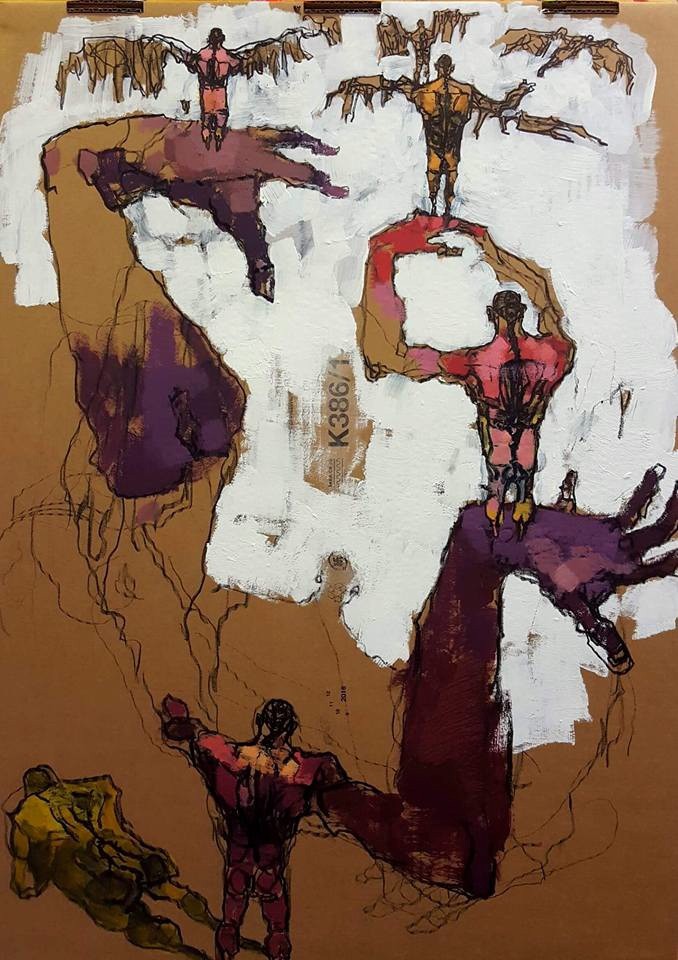
Circle, 2016, 80 X 60cm, painting/drawing on cardboard
A second art series has the theme of the wall, which is symbolic of the knowledge, good and bad knowledge, that we learn at school and at the university. Man-made knowledge helped people, but at the same time destroyed our unity, our humanity.
Many of my series – like these two – have one thing in common. They all deal with questions of my own identity. They are a mirror of my daily life, my experience of social life, politics and culture.
My last exhibition entitled “Lockdown 2020” is a combination of two series, “Who’s in our shoes” and “Lockdown”. In the two series I work on the current situation regarding COVID 19, “Black Lives Matter” and the political crisis in my home country Ethiopia, which is just one example of the risk of conflict in many countries.
“Who’s in our shoes?”, consisting of pictures and an installation, invites the viewer to a philosophical search for identity and the question of isolation. The shoe does not represent or show the original identity of all people. I use the shoe as a symbol of our knowledge that we learn mainly from school and universities. We are where we are. If you are in Africa, you can wear a different style of shoe, which in turn represents a different knowledge. If you are born in Europe, you could have a different shoe, which symbolically represents a different mentality. Some shoes do not fit on the sole of your foot, other feet do not fit in your shoe and some feet have a completely different character, like 6 or 7 toes. Sometimes I draw 8 toes on a foot and it represents not only one foot in a shoe, but two feet in a shoe and a foot trying to cover the other foot. The critics see our daily life in the art society, in politics and also in the religious peoples. They cover up the truth and the original foot. I use black and white tape cross lines on the artworks to close them, to think of the peoples who lost their lives and at the same time to remind the viewers of the present. It is about a time, it is about the now!
With “Lockdown 2020” I would like to address viewers whose interest is to hear and think about our present situation. The exhibition consists of two installation artworks. One of them is the map of the world, which is lying on the ground, cut up and damaged. It is symbolic of how nature has already suffered so much at the hands of man and yet it keeps embracing us, even though we keep gnawing at its flesh. The second part of the installation is a birdcage with a metal chain hanging in the middle of the room. Inside the birdcage are many cut out maps from an atlas. The cage symbolizes our situation. In another room there is another installation art, which covers a variety of studio materials like chair, table and books with plastic foil. It stands for the time when everything was closed in 2020, the borders, big companies, airports, schools, museums and galleries. All the works of art and installations in the series are taped with black and white tape, symbolically like a cross, to show that in this situation it doesn’t matter what nationality or religion someone belongs to, what color of skin they have and whether they are rich or poor. We are all the same, no matter what our original identity is, which I symbolize by the feet. We were all born as gold, but now we are all locked up like wax. At the end is the black and white cross, which stands for the peoples who have lost their lives in this situation before, now and afterwards.
Do you think that Western culture damaged the traditional African culture?
Yeah, definitely. It has been damaged incrementally. The first step and the first great damage were colonization and slavery! No one can repair that damage. I come from a country, Ethiopia, that was never colonized. I want to pass on my love and respect to my companions who went to war against colonization and defeated Italy. Today I am proud of these people and being Ethiopian, but I have never forgotten that I am also African. And the rest of Africa was colonized. People in the colonized countries lost their original name, tradition, culture, language and religion. All this has been changed by Western cultures. This is a great damage that no one can make up for. After colonization, step by step until today, we are all shaped by the Western school system, the Western political system and even the Western spiritual system. You see, there are a lot of levels of damage that I try to express in one of my art series “Wall”. There are many blank pages out there in the book of history.

Blond wings in Africa, 2017, 80 X 60 cm. painting/drawing on cardboard
You have a very recognizable style. Can you tell more about it? About the mixture of drawing and painting, about the use of cardboard, about the size of the works (small, big, the whole wall…).
My style is freedom! I love to paint and at the same time I love drawings, I try to combine them, and this combination forms my style. But I don’t want this style to become a prison cage, because it is always repeated. I just want to be free and keep working and people can say for all I care, this is his style or this is Girmachew.
On the use of cardboard: I have been working on paper and cardboard for many years, but since 2015, in accordance with my philosophy, I have been working with a focus on cardboard. I have painted all my art series on industrial packaging board since then. I have used this material because I believe that it is a wise choice to work with nowadays, because of its simplicity and also because it is classic and a common material. Cardboard is light, easy to transport and can easily change its shape; therefore it does not take up much space. My interest in using this material has a lot to do with color and texture. This particular paper is a wonderful and excellent material for my drawings and paintings. Working on cardboard gives me a feeling of freedom, it is so easy and ordinary to maintain. With this attitude of mind I can better express what I want and focus on the message. That’s why I believe that art is not just about being talented and educated, but more about experiencing the feeling of freedom. I was also inspired by the production of cardboard for its use. The cycle of cardboard production represents the life process in which the tree becomes paper, from paper to recycled paper, from recycled paper to cardboard, from cardboard to paper waste, from paper waste to recycling and so on. Cardboard has been part of our daily life for generations, people use cardboard to package new products or to store old things or to keep documents, and then we just throw it in the garbage, so it turns from a part of life to waste. In my work I turn waste into gold, waste into life, the bad into the good.
In terms of size, I am a person who paints and draws a lot. Sometimes I start with 5 to 8 pictures and draw them at the same time, sometimes I start with a small work of art and develop it into a big one that covers a whole wall. I enjoy this and I love the freedom in it.
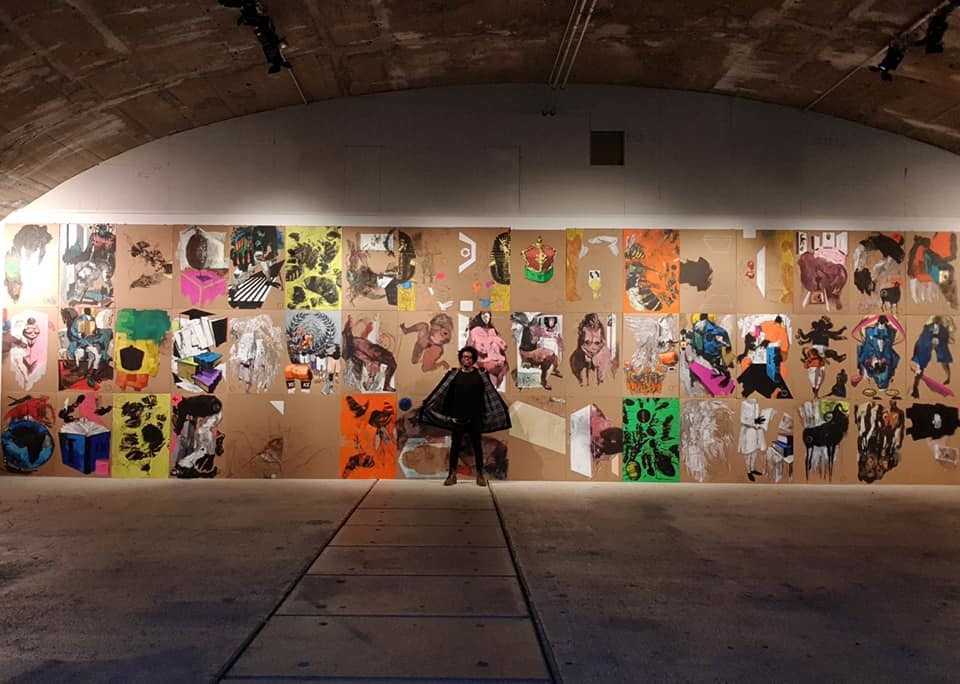
Installation view “Girmachew Spiegel (mirror)“, 2019, Kunstverein Familie Montez {selected works from latest series (2015-2018)}
Your work is at the base figurative, but you kind of exaggerate the reality. Am I right? Do you have a reason for it?
I believe in creation and the universe. What percentage of the universe do we know as human beings? Four or five, six percent of the universe?
The other 96 percent is made up of things astronomers can’t see. Sometimes I have such an image here in my brain, in search of the unknown; I draw a figure between reality and dream, between trying to create a new figure that is known and an unknown feeling. I always like a painting style based on exaggerated elements of the human figure, without limits! But before distorting, you have to learn to draw and paint realistically.
The persons in your work are often turning their back on the viewer. Why?
From my character I am transparent and direct. But I remember that in 2011 I painted a painting with the name Sem (Shem), Iafeth (Japheth) and Cham (Ham). On the painting you can see the three men. They form a circle of unity and imprecision by turning their backs on the viewer. The painting is meant to symbolize the table of the nations of all people, the unity of all races.
Both in my art and in my personal everyday life I am not a person who follows the crowd. I turn my back to the crowd and walk and look ahead, in Amharic, my mother tongue we say “ወደፊት ሂድ”.
Your work has often empty spaces. Do you do that on purpose?
Yes, I need space to understand myself, and I often give the viewers a free space in my works of art so that they can communicate in their own language.
In 2007, I was invited by the Grassi Museum in Leipzig to present a large solo exhibition, the title and central theme of which was “Free Space“.
Are there Western artists you admire?
The Russian painter Mikhail Vrubel is one of my favorite artists. I did not have a chance yet to see his original paintings as most of them are in Russian Museums. I hope to see them in future. I also appreciate some more western artists and I am happy that I had the chance of seeing their originals in Museums.
Kerry James Marshall wanted to be included in the canon of the (Western) art history. What is your big dream?
My big dream is to continue working without pressure and to stay outside the system. It is not my dream to be in this art-historical cage, I call it cage, because I see many young artists suffering in this art circle. There is something in my opinion. Art becomes something to satisfy the needs of others and to keep them company. In the art world, my dream is to open an art museum and an art space in Ethiopia or Africa that supports very young artists and encourages them to stay away from the system.
